Tourism Basics for Rural Alaska
CRD-00014 View this publication in PDF form to print or download.
The Very Basic Basics
You love your community and the land. You couldn’t think of living anywhere else.
You think people would enjoy coming to your village for the experience that you experience every single day. Does that mean you should invite people to your village and start a business in tourism?
In other words, is tourism right for you and your community?
Ask yourself — What kind of a community do you want to live in? What are the things you don’t want to change? What is sacred to you? What would you not mind sharing?
Tourism will bring changes, for at least part of the year.
Are you and your neighbors okay with that?
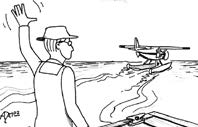
The good news is that you and your neighbors can control your local industry. You could have a short summer season for instance, to leave you time to do your other work. Or you could bring tourists to a camp outside the village.
You must think about the changes that tourism could bring and who could be affected. Then talk to all of those people before you start inviting tourists to your village.
Have community meetings where all the interested parties are involved. Involve the general public in the process since they may also be affected.
Local people who are unhappy with the tourists will make the tourists unhappy, too.

BUT — if your community is like most villages, you may be in the tourism business already, without even knowing it.
You’re Already in the Tourist Business
Tourism is a good alternative for economic development in rural Alaska. But tourism is very different from other industries where you produce a product and ship it to your customers. In effect, it is your customers who are “shipped” to you.
Tourism is different for the customers, too, who must make their purchase sight unseen. Therefore, it is vital to make sure the tourists know what to expect.
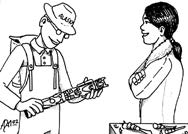
Money can definitely be made in tourism. But who gets to keep the money?
Tourism can be planned primarily to create jobs with already established companies who come from outside the village to set up shop. These jobs may be seasonal and adequately paid. But it may be better to encourage local people to start or expand their businesses so that most of the profits from tourism can stay in the village. Local businesses can provide a unique product. And keeping the businesses in local hands is a good way to ensure that local issues will be addressed.
Tourists from the Lower 48 and international tourists may be interested in many things rural Alaska has to offer. A tourism business could be wildlife-based, such as a wilderness guide for hunters or photographers. Other businesses could be based on arts and crafts, cultural performances or nearby geographic features, such as volcanoes or rivers.
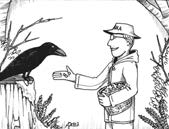
Successful rural tourism businesses might be built around a festival at berry harvest time, for instance. As part of their time in town, tourists could help harvest the berries for you, and pay money for the privilege of doing so! Success depends on who the tourists are and what they expect to find.
Tourist attractions could also be built around a berry festival or fish camp, or already functioning hunting and fishing lodges. One group has based tourism around archeological excavations, where the tourists work with scientists as part of their experience.
If You Decide to Do It...
Again ask yourself — What is it that is sacred that we don’t want to “sell.” And what is it that we are willing to share with strangers? You have decided to invite tourists to your village — now is the time to do an inventory of your community’s strengths and weaknesses.
Do you have places for people to stay? To eat? To fill their time?
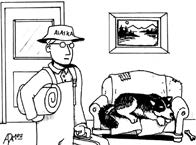
You must be very honest about your facilities. Then, the job is to find people who want that experience, not to lure people with false promises or incomplete information.
But people may be seeking a rustic or authentic experience and may relish the experience, providing they know to bring their own medicine, for instance.
Or even food and water if necessary.
A good practice is to send to all tourists — before they arrive — a complete list of what they might need to remember to bring. If there is no pharmacy in the village, for instance, they need to bring their medicines.
“This is what you will encounter” your list should also say. For instance, we have a wonderful glacier-fed water source for our village, but the water is not treated.
People from Outside may have a lot of assumptions that do not necessarily hold up once they get to rural Alaska. Flush toilets, for instance.
You can make it sound like an adventure. Consider words such as “rustic” or “bare bones” to describe your facility.
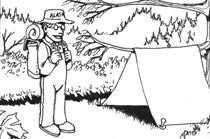
You may want to say, “This is like going camping. Bring everything you would need on a camping trip. Except this is the tundra, so you won’t have a tree to go behind to do your business.”
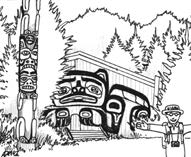
People may be sitting around the village for a night or two. Are they welcome to come to bingo? How about a religious service or a social event? You must think about activities to keep your guest entertained, as well as fed and housed.
How Do You Reach Your Customers?
Check out the market! What other people are offering is a good way to gauge what it is people want. If you have a brand new idea, you are taking more chances. But you could be very successful, too.
How are people going to find you?
Talk to people from the regional or village corporation. They may have a website where you could place an ad. Advertisements in magazines catering to your target (hunters, birders, etc.) are another way to put your name before the public. It’s okay to offer to communicate with guests only by mail or phone, if the Internet is not easily available.
Your local school may allow you to send and receive messages on their computers.
There are government organizations that provide guidance for people starting new small businesses. And other government organizations have collected a lot of information about tourism. The University of Alaska Cooperative Extension Service is another resource.
It may be a good idea to look around for businesses you may want to partner with. An airline that serves your area, perhaps, could help you by bringing the tourists to your village. Or the local school district may have facilities you can rent for your guests, especially in the summer months.
It may be useful to contact the following organizations:
Alaska Wilderness Recreation & Tourism Association:
www.awrta.org
in Anchorage 907-258-3171
Alaska Small Business Development Center:
in Anchorage, 907-274-7232 or 800-478-7232
in Fairbanks, 907-456-7232
in Juneau, 907-463-3789
also in Bethel, Ketchikan, Soldotna and Wasilla
Alaska Office of Tourism Development, Alaska Department of Commerce, Community and
Economic Development:
www.commerce.state.ak.us/ded/dev/toubus/home.cfm 907-465-5478
To find potential partners, look in the phone book and, especially, talk to people as much as you can. Do a web search or have one done for you.
From the all-important “marketing” standpoint, you should try to “get there first.” If you know someone who has a parcel of land by the river, why shouldn’t you or your partnership be the one to lease t for setting up camps or putting up a lodge?
Your Strategic Plan
Your plan should ask: What are the effects on the community? Who benefits from the enterprises?
The three main goals are to
— maintain community health,
— make sure your community is not controlled by tourism, and
— make sure local people benefit.
The money that goes to the community might be as low as 10 percent or less if you go for a quantity experience — such as busloads of tourists brought in by an outside firm.
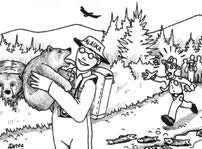
It is more likely for rural Alaska to have fewer visitors and retain more of the economic benefit.
Don’t invite a whole lot of hunters or fishermen before you have made basic assumptions and analysis.
It may take longer, but it is worth it to ensure your community is one that controls and will benefit from tourism and not vice versa.
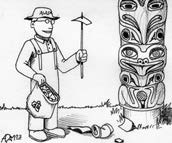
Encourage coordination with government agencies. For instance, what will be the effects on the community infrastructure? The village or tribal government, for instance, might be doing something completely at odds with your plans
The economic impact of government regulation of public lands in Alaska is huge. For the most part, what tourists are coming to Alaska for is the land.
A government agency may decide how many, say, rafting trips, are going to be allowed in a certain area. The agency could be too generous (as well as too restrictive) and destroy the resource.
The people who control the product are often not in the community and need to be helped to understand local issues. Make sure your village’s concerns are addressed early in the process. Also for that reason, consult local businesses so they can become involved. Get the public involved.
In addition to contacting your local ANCSA Regional Corporation, it may be useful to contact:
Alaska Department of Commerce, Community and Economic Development, Tourism Development
and Marketing:
https://www.commerce.alaska.gov/web/ded/
(907) 269-8150
Alaska Travel Industry Association
https://www.alaskatia.org
(907) 929-2842
Tourism can contribute to the infrastructure — both government and individual businesses — and care should be taken so that the services are also available to locals. You don’t want your public money used to build things that only serve tourists. But if both can benefit, so much the better!
Tourism can also provide employment, especially for young people. With proper planning, village residents can be employed providing tourists with subsistence and cultural information, travel help and with other personal needs.

Stephen Brown, Extension Faculty, Agriculture and Horticulture. Originally prepared by Will Swagel and Robert Gorman. Illustrations by Adam Frank.
Reviewed March 2021
